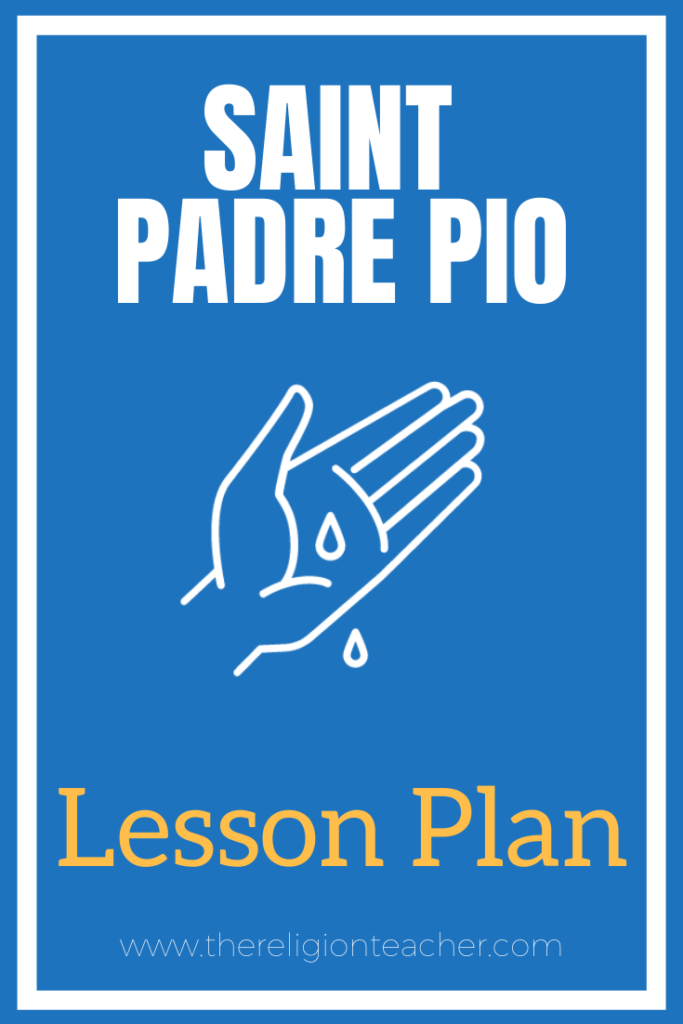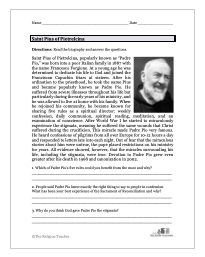
Teach your students about the life of Saint Padre Pio in this lesson plan and encourage them to reflect on how they can become more like him today.
The format for the lesson is a simplified version of Lectio Divina Lesson Planning called The RE3 Framework: Read, Reflect, and Respond. Learn more about The RE3 Framework here.
Saint Padre Pio Lesson Objectives
- Students will be able to (SWBAT) summarize the life of Padre Pio.
- SWBAT select one of Padre Pio’s five rules to practice in their own lives.
- Students will feel fascinated by the life and spiritual gifts of Padre Pio.
Read
Watch this video about the life of Saint Pius of Pietrelcina (Padre Pio):
Members: You can download this video to show in class here.
Or read this short biography about Padre Pio:
Saint Pius of Pietrelcina, popularly known as “Padre Pio,” was born into a poor Italian family in 1887 with the name Francesco Forgione. At a young age he was determined to dedicate his life to God and joined the Franciscan Capuchin friars at sixteen. After his ordination to the priesthood, he took the name Pius and became popularly known as Padre Pio. He suffered from severe illnesses throughout his life but particularly during the early years of his ministry, and he was allowed to live at home with his family. When he rejoined his community, he became known for sharing five rules as a spiritual director: weekly confession, daily communion, spiritual reading, meditation, and an examination of conscience. After World War I he started to miraculously experience the stigmata, meaning he suffered the same wounds that Christ suffered during the crucifixion. This miracle made Padre Pio very famous. He heard confessions of pilgrims from all over Europe for 10-12 hours a day and responded to letters late into each night. Out of fear that the miraculous stories about him were untrue, the pope placed restrictions on his ministry for years. All evidence showed, however, that the miracles surrounding his life, including the stigmata, were true. Devotion to Padre Pio grew even greater after his death in 1968 and canonization in 2002.
Reflect
Have students answer the following questions:
- Which of Padre Pio’s five rules (weekly confession, daily communion, spiritual reading, meditation, and an examination of conscience) could you benefit from the most and why?
- People said Padre Pio knew exactly the right thing to say to people in confession. What has been your best experience of the Sacrament of Reconciliation and why?
- Why do you think God gave Padre Pio the stigmata?
Download and print this worksheet with the biography and questions all in one:

This worksheet is one of more than 150 printables in The Religion Teacher’s Saints Worksheet Collection.
Respond
Saint John Paul II had the opportunity to go to confession with Saint Padre Pio as a young man. Decades later the pope would oversee the saint’s canonization. During the ceremony on June 16, 2002, John Paul II prayed this prayer.
Join together in praying:
Humble and beloved Padre Pio,
Teach us, we ask you, humility of heart so we may be counted among the little ones of the Gospel, to whom the Father promised to reveal the mysteries of his Kingdom.
Help us to pray without ceasing, certain that God knows what we need even before we ask him. Obtain for us the eyes of faith that will be able to recognize right away in the poor and suffering the face of Jesus.
Sustain us in the hour of the combat and of the trial and, if we fall, make us experience the joy of the sacrament of forgiveness.
Grant us your tender devotion to Mary, the Mother of Jesus and our Mother.
Accompany us on our earthly pilgrimage toward the blessed homeland, where we hope to arrive in order to contemplate forever the glory of the Father, the Son and the Holy Spirit.
Amen.


